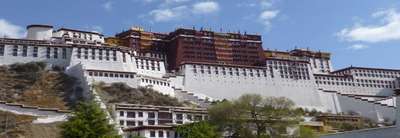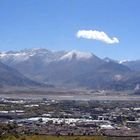TIBET
The Tibet Autonomous Region, perched on the southwest Qinghai-Tibet Plateau, is a southwestern frontier region in China. At an average altitude of 4,000 metres, Tibet is the world's largest and highest plateau known as the 'Roof of the World'. The world's largest canyon the Yalung Zangbo Canyou, is in Tibet. In the mid-7th century, Songtsen Gambo established the unified Tubo dynasty and befriended the Tang Dynasty by marrying Princess Wencheng in 641 AD. In the mid-13th century, Tibet was incorporated as an administrative region of the Yuan Dynasty. Peaceful liberation came in 1951, and serfdom was abolished during the Democratic Reform of 1959. The Tibet Autonomous Region was officially established in 1965.
Breathtaking is hardly an adequate word for Tibet's landscape, which consists of snow-capped mountains of astonishing heights, primitive forests, vast steppes, mighty rivers, the world's highest lakes, and exotic wildlife and plants. Tibetans, who make up upwards of 90 percent of the local population, are born singers and dancers with a splendid civilization. Buddhist art thrives, and among the region's 2,700 temples are such famous ones as the Potala Palace, the Norbulinka Palace, the Jokhang Temple, and the Tashilhunpo Monastery.
Climate: Lhasa, the "City of Sun," is nestled high in the Gyi Qu Valley and is blessed with seasonally mild and humid weather from monsoons in India 160 km(100 mi.) to the south. Tibetan winters, as might be supposed, are fiercely cold. But for half the year, strong sunlight warms the thin air, making most days in Lhasa comfortably mild and, owing to protective mountains, relatively windless. Summer temperatures hover above 30'C (high-80s F) and only to drop to a searing -23'C (-10'F) in midwinter. The best time to visit is from late spring to early fall.
Tibet Permit and Visa Rules:-
Tibet is officially a province of China, so a valid China visa is required to travel to Tibet (except if you enter Tibet from Nepal, please see the Tibet group visa section if you enter Tibet from Nepal). As Tibet is different from other places in mainland China, you need some additional travel documents or permits to travel. Please check the details below:
Types of Tibet Travel Permit to travel Tibet:
1) China visa or Tibet Group visa
2) Tibet Travel Permit (TTP)
The Tibet Travel Permits are based on the region/places that you travel in Tibet, so the Chinese visa/Group visa and Tibet travel permit is compulsory for all types of Tibet tour.
1. Chinese Visa / Tibet Visa or Tibet Group Visa
Tibet is officially a province of China, so every traveler must have a valid passport and Chinese visa to enter Tibet (except if you are entering from Nepal). A Chinese visa is generally obtainable from most Chinese embassies and consulates in your area and must be obtained in advance.
Tips: Since Tibet is a politically sensitive area, the Chinese Consulate or Embassy may refuse your visa application if you list Tibet as a travel destination. We recommend choosing an alternate city in mainland China such as Beijing, Chengdu, Shanghai etc. as your destination. If you are entering Tibet from Nepal, you will need to obtain the Tibet Group Visa from the Chinese Embassy in Kathmandu. It is an A4 size sheet of paper with the name, sex, nationality, passport number, date of birth and occupation of each member listed in your group. The dates of entry and exit are precisely recorded. All travelers in the group must enter and leave China together. To apply for the Tibet Group Visa, you will need a visa invitation letter from the Tibet Tourism Bureau sent by a tour agency in Tibet. Our office in Lhasa can prepare the necessary arrangements and send them to our local agent in Nepal to help travelers apply for the Tibet Group Visa.
2. Tibet Travel Permit (TTP)
Often mistakenly known as the “Tibet Visa,” the Tibet Travel Permit (TTP) is actually the entry permit to enter the province. TTPs must be applied through a travel agency in Nepal and Tibet. It is impossible for foreign tourists to board a train or flight to Tibet without a TTP. The permits specify every destination and attraction you will visit on your tour and cannot be changed once you arrive in Tibet. Therefore it is essential that you finalize your itinerary with your tour operator before they apply for the TTP. If you hold a visa different from the (L) Tourist visa, such as a student or work visa, you will need a letter from your school or company to clarify the purpose of your visit.
How to obtain the Tibet Travel Permits (TTP)?
The Tibet Travel Permit (TTP) is necessary for foreigners to get into the Tibetan Autonomous Region. We can apply for the permit for you and currently according to the Tibet tourism bureua policy, all the permit application should be submitted at least 15 days before the trip starting date, but if you are traveling into restricted areas, then you need more additional permits and documents which will take longer time. Once you confirm your trip with us, we request you to send us a clear scanned copy or photo of your passport and Chinese visa at least 20 days in advance by email as it is required for applying for the the Tibet Travel Permit. When the permit is issued we will send a copy or original of the permit to your hotel in China. If you will fly into Tibet then we will send the original permit to your hotel in China in order to board train or flight from China, The original copy of permit is required. If you will take the train into Tibet, then we will send a copy of the permit by email and you can bring a copy to board the train.
Note: Diplomats, Journalists, professional media photographer and government officials are not able to issue their Tibet permit through ordinary travel agencies. They are only able to travel Tibet under the arrangement of Foreign Affairs Department, Economic Development Committee, etc.
Important Tips from us - How to apply for Chinese visa?
It’s best not to mention Tibet or any places in Tibet as your travel destination when you are applying for Chinese visa (the Chinese Embassy in Kathmandu is the only exception). Since Tibet is politically sensitive in China, your consulate may refuse your visa application if you mention travelling to Tibet in your application form, so please keep this in mind when applying. You can mention any city of mainland China such as Beijing, Xi'an, Shanghai, Chengdu-Sichuan, Yunnan, etc. as your travel destination.
Tibet Group Visa—Documentation for entering Tibet from Nepal
Entering Tibet via Nepal by land or air
If you plan to enter Tibet from Nepal, you must get your Tibet group visa from the Chinese embassy in Kathmandu. Whether you already have a Chinese visa or not, a Tibet group visa is compulsory for all tourists entering Tibet from Nepal. Tibet group visa is on paper not on passport, with the name, sex, nationality, passport number, date of birth and occupation of each member of your group listed. The dates of entry and exit are precisely recorded. Usually, the visa is valid only for the length of the trip you have booked but it's possible to extend the visa for few additional days, but only for staying in Lhasa. There will be two original copies of the Tibet Group Visa, one for immigration at entry and another for exit.
I have Chinese Visa obtained in my country is it valid to enter Tibet from Nepal?
As you need Tibet group visa in order to enter Tibet from Nepal, your Chinese visa will be canceled if you want to enter Tibet from Nepal by land or air. So be sure before taking decision. But It is possible to enter Tibet via mainland China cities.
Is it possible to travel China with my Tibet Group Visa and Can extend it?
Usually from 2017, The group visa validity will be maximum 30 days on request. You could travel both Tibet and China. It is not extend-able.
For visa latest news please contact us at snftnepal@yahoo.de
Regions in Tibet
Click on Details & Trips for further information and activities
EASTERN, CENTRAL AND WESTERN TIBET
As the political, religious and economic heart of the Tibetan world, Lhasa finds its place on the north bank of Lhasa River with an altitude of 3658m (about 12000 feet). In Tibetan, Lhasa means "The land of the Buddha" or "Holy Place". The city has a long history of 1300 years with a population of 400,000.
Blessed with flat land and mild climate, Lhasa is free of frigid winters and unbearably...
Details & Trips








